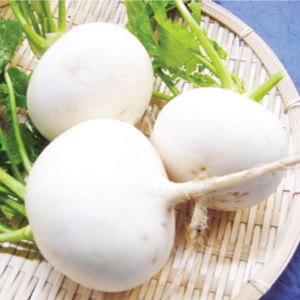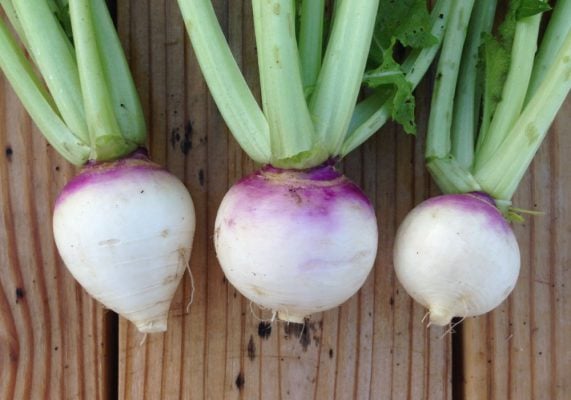
Learning Download: How to Grow Turnips
From Seed to Harvest: A guide to growing turnips.
Turnips are a unique vegetable in which both parts, the root and the leafy greens on the top, can be eaten. Some turnips are grown primarily for their turnip greens, while others are grown to harvest the root. Turnips are commonly used in soups or stews and the turnip greens can be used in salads or cooked.
To plant:
Since turnips are a root plant, they don’t always transplant well from indoors to the garden. Turnips are hardy and can withstand frost, so sow directly into the garden five weeks before the last frost date. Plant seeds 1/2 inch deep and 1 inch apart in rows set 1 foot apart in rows set 1 foot apart. Turnips can be grown twice, during the spring and during the fall. Do not grow turnips over the summer. If growing in the fall, plant the seeds near the end of the summer. Stagger turnip planting to every 10 days to allow for a continual harvest. Prior to planting, be sure to till the soil and remove any debris to allow space for the turnip root to grow underground.
To grow:
Once seedlings appear, thin to every 4 inches. Provide ample watering for the turnips because one of the biggest causes of a root with a woody texture is dry soil. Like most vegetables, turnips prefer full sun but if they are grown solely for their leaves, they will tolerate partial shade. Turnips can have issues with pests like slugs, snails and aphids, but the turnip growing season is short so typically the vegetable is harvested before the pests become an issue.
To harvest:
Turnips are ready to harvest 40 to 55 days after planting. If harvesting the leaves, they are ready when they reach 4-6 inches in height. If only harvesting the leaves, cut them from the plant when they reach the desired size, leaving 1 inch of leaves above the crown of the plant. More leaves will grow in their place. If harvesting the whole plant, gently dig the turnip from the ground. If harvesting for both the root and the leaves, the turnip should be about 2 inches in diameter, but if the leaves have been harvested first, the turnip should be 3 inches in diameter when it is ready to be pulled. Pick turnips when they are smaller for a milder, sweeter flavor.
What turnips crave:
Prior to planting, work compost and an all-purpose fertilizer like a 10-10-10 variety into the top 6 inches of soil. How you fertilize turnips will depend on what you are growing them for. If you are only growing turnips for the turnip greens, use a fertilizer high in nitrogen as it encourages leafy growth. Apply a side dressing of 34-0-0 or 21-0-0 six weeks after the plant emerges. Use a more balanced fertilizer if growing for the roots.
Where to buy turnip seeds:
You can find different types of turnips at Urban Farmer.
Learning Download: Common pests and diseases: Turnips
Common pests and diseases: Turnips
When growing vegetables, it is always exciting to care for the plant throughout its growing phase and then harvest it for delicious recipes later on, but one thing to watch out for is pests and disease. Different plants are susceptible to different types of pests and diseases, and it is important to make yourself aware so you can keep a watchful eye and also take any preventative methods to keep your plants safe throughout their lifespan.
Turnips can fall victim to several different pests and diseases.
Pests:
Some of the common pests affecting turnips include aphids, wireworms and root maggots.
Aphids are soft-bodied insects that bring problems to lots of plants. They create discoloration of the leaves, necrotic spots and stunted growth. Use tolerant varieties and only apply insecticides if there’s a high infestation.
Wireworms will cause seedlings to die and also cause girdled stems. Till the soil frequently to reduce the amount of wireworms and rotate crops to a non-host crop the following year if possible.
Root maggots will cause scars on the surface of the turnip and feeding tunnels as well. The damage done to the roots may be extensive. The larvae are white and yellow in color and the adult resembles a horsefly. To manage this, avoid planting crops in the same area the following year if you notice a problem. Utilize floating row cover to prevent the females from laying eggs.
Diseases:
Some of the common diseases affecting turnips include Alternaria leaf spot, clubroot, downy mildew and white spot.
Alternaria leaf spot causes small, dark spots on the leaves which will then turn brown or gray. This disease favors cool, wet weather. To prevent this from happening, plant only pathogen-free seed, practice crop rotation and apply the appropriate fungicides when needed.
Clubroot causes slow growing or stunted plants with leaves that yellow during the day, wilt during the day and then become rejuvenated at night. To prevent this from happening, plant only disease-free seed and apply lime to the soil.
Downy mildew causes lesions on the upper surface of the leaves and a white growth on the bottom of the leaves. It favors cool, damp weather. To prevent, remove all crop debris and rotate crops.
White spots causes small, necrotic, brown spots on the leaf tips or the margins of the leaves, and the brown will mature to a light gray or a white color. These lesions may cause defoliation, and the disease is more likely to emerge in cool and wet conditions. To prevent this from happening, practice crop rotation and removing weeds because there is no known plant resistance to white spot. Also, you can apply the appropriate fungicides to help fight the disease.


